China's presence looms amid massive U.S.-Japanese AnnualEx war games
November 28, 2013 -- Updated 1437 GMT (2237 HKT)
STORY HIGHLIGHTS
- USS George Washington in huge naval exercise -- AnnualEx 2013 -- off Okinawa
- CNN reporter aboard carrier as dozens of warships, subs and aircraft take part
- This year's games held against backdrop of tension after China imposes new air zone
- China announced a new Air Defense Identification Zone, angering U.S. and Japan
USS George Washington, East China Sea (CNN) -- The deafening roar of state-of-the-art warplanes being catapulted into the air from its huge flight deck signaled that the USS George Washington was back in combat mode after its recent detour to the Philippines to take part in the aid effort in the wake of Super Typhoon Haiyan.
Barely a week on and the 90,000-ton Nimitz-class aircraft carrier is now patrolling waters off the island of Okinawa as part a huge naval exercise -- AnnualEx 2013 -- involving dozens of warships, submarines and aircraft from the U.S. Navy's 7th fleet and the Japan Maritime Self-Defense Force (JMSDF).
The aim? To provide a stern test of their ability to effectively and mutually respond to the defense of Japan or to a regional crisis or contingency situation in the Indo-Asia-Pacific region, according to the U.S. Navy.
But this year's war games have taken on an added dimension given the high-pressure atmosphere in the region at present -- they take place in the shadow of a controversial new Air Defense Identification Zone announced by the Chinese last weekend.
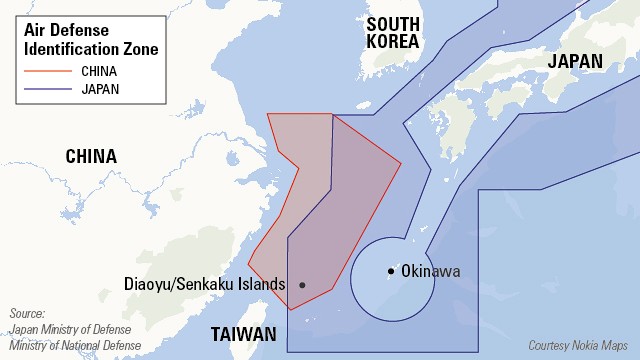
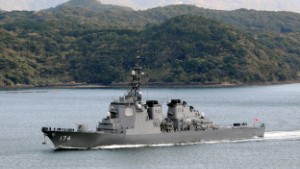

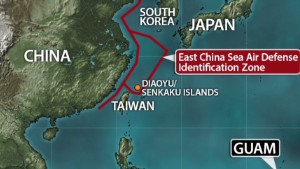
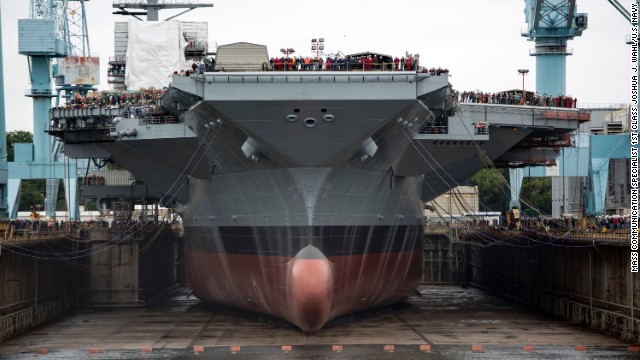
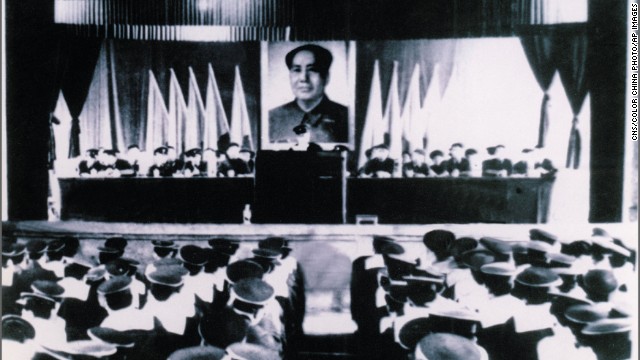
This zone, which incorporates among other areas an East China Sea island chain at the center of an acrimonious tug of war between Tokyo and Beijing, requires that all military aircraft in the area must report their flight plans to China, maintain two-way radio and clearly mark their nationalities on the aircraft. China has warned it will take "defensive measures" if their orders are ignored.
'Steady as you go'
The commander of the U.S. 7th fleet, Vice Admiral Robert L. Thomas, appeared relaxed about the situation while addressing a group of reporters aboard the USS George Washington. He said while China's air defense zone did not appear to be "well thought out" given the overlap with both Japanese and South Korean territorial claims, he did not think U.S. military activity in the region would be negatively affected.
"We are going to continue with our operations in international airspace as we always have," he said. "It's about international norms, standards, rules and laws. When anybody makes an extreme claim it is really an imperative that the international community can continue to operate in accordance with international law and not be distracted.
"So for us it's 'steady as you go.' Our operations in the East China Sea will continue as they always have."
'Profoundly dangerous'
Japan, which administers the largely uninhabited island chain -- known as Diaoyu by China and Senkaku by the Japanese -- has described China's move as "a profoundly dangerous act that may cause unintended consequences in the area," while U.S. Secretary of State John Kerry said "this unilateral action constitutes an attempt to change the status quo in the East China Sea. Escalatory action will only increase tensions in the region and create risks of an incident."
China has rebuffed any criticism by stating that its action is not directed at any one in particular, and that other countries -- including Japan -- have established similar control zones in the past.
In recent months, both sides have been involved in a dangerous game of "cat and mouse," prompting fears that any miscalculation could set the two Asian powers on a collision course -- with the United States likely to be dragged into such a conflict to defend its Japanese ally. Tokyo says it has twice scrambled fighter jets this month after Chinese aircraft appeared on course to enter its airspace. For its part, China lodged a complaint after it said a Japanese warship recently entered waters where the People's Liberation Army (PLA) Navy was holding live-fire drills, noting "the provocative move may have led to unexpected emergencies."
For us, it's 'steady as you go.' Our operations in the East China Sea will continue as they always have.
Vice Admiral Robert L. Thomas
Vice Admiral Robert L. Thomas
Meanwhile, China's first aircraft carrier, the "Liaoning," set sail this week from its home port of Qingdao in eastern China. According to the PLA Navy's website, it will head for the South China Sea to "conduct scientific experiments and military training." This course would take it through the East China Sea accompanied by four other warships.
Restraint
Yet with so many potential flashpoints in the region, Thomas is optimistic that conflict will be avoided. He pointed to the professionalism shown by the armed forces on all sides in the region as the basis for this confidence.
"The South Koreans have shown great restraint with regard to North Korea and those severe provocations, while the Japanese Self Defense Force has also been very measured," he said. Significantly, he pointed to China's development of a "world class" navy, with a level of professionalism that matches its improving infrastructure.
"The more confident they become in their own capabilities, then this will actually 'depressurize' the situation," he said. He added that the People's Liberation Army Navy was no longer an unpredictable, conscription-based force training only at certain times of the year.
He said the PLA Navy was now showing signs of being able to operate far beyond its own waters, carrying out missions -- such as anti-piracy patrols -- that could make it a useful and responsible global operator.
Humanitarian challenge
With F-18 fighters taking off and landing almost every few minutes, it was easy to forget the role the carrier played in the Leyte Gulf more than a week ago. Many of its fighter jets were flown back to Japan to make room for more helicopters able to ferry in supplies to remote areas of the Philippines in the wake of Super Typhoon Haiyan.
"The ship became a 'lily pad' for relief operations," said the carrier's commander, Rear Admiral Mark Montgomery. "This is something we'll train more for," he added, citing the need for a modern navy to be able to adapt to an increasingly diverse range of challenges and missions within its theater of operations.
"It was humbling to be able to take part in the extraordinary humanitarian effort in the Philippines."
Yet the sight of dozens of warships in tight formation in high seas off Japan was another reminder of how serious the U.S. and Japan are taking the threat to regional security -- undeniably their biggest challenge.
We recommend
From around the web
- Rios says he wasn’t hurt, lauds Pacquiao’s speed(Inquirer.net)
- Manufacturing lessons from Germany (TradeGood)
November 28, 2013 -- Updated 1437 GMT (2237 HKT)
CNN goes inside the massive annual U.S.-Japan naval exercise off Okinawa, where tensions are now rising after China's controversial move.
November 27, 2013 -- Updated 2039 GMT (0439 HKT)
As little Ella-Louise faded away, her frail body wracked with pain, her mom felt powerless.
November 27, 2013 -- Updated 0918 GMT (1718 HKT)
A genetic disease called neurofibromatosis has left Vinicio Riva disfigured. He is used to cruelty -- but felt "great warmth" from the Pope.
November 27, 2013 -- Updated 1716 GMT (0116 HKT)
Where has euthanasia been legalized and where have changes to the law been discussed? Explore our interactive map to find out.
November 28, 2013 -- Updated 1719 GMT (0119 HKT)
The celebrity chef's ex-husband alleges she took drugs as the trial of their assistants resumes.
November 28, 2013 -- Updated 1410 GMT (2210 HKT)
The fall harvest has a way of making people giddy. Around the globe, folks dance, sing, race cows, and even parade around giant phalluses.
November 28, 2013 -- Updated 2009 GMT (0409 HKT)
Comet ISON is "alive and brightening dramatically" as it nears the sun, according to a website observing its journey.
November 28, 2013 -- Updated 1139 GMT (1939 HKT)
With less than a month until Christmas, toy retail experts are tipping flying robots to be among this year's "must-have" gifts.
November 28, 2013 -- Updated 1118 GMT (1918 HKT)
Alex Caizergues smashed the World Sailing Speed Kitesurfing record over 500 meters, reaching an average speed of 56.62 knots.
November 28, 2013 -- Updated 1258 GMT (2058 HKT)
A group of tech-savvy entrepreneurs are setting out to rock Nigeria's vibrant music scene by cashing in on the booming mobile phone market.
November 28, 2013 -- Updated 0246 GMT (1046 HKT)
Western students receiving their education in the UAE is not as far-fetched as it might sound. Some universities have set up outposts in the Gulf.
November 28, 2013 -- Updated 1353 GMT (2153 HKT)
Go behind the scenes of CNN news reports with these photographs from CNN reporters and producers around the world.
Most Popular
Today's five most popular stories
48°
HI 48°LO 29°
Atlanta, GAWeather forecast
Home | Video | World | U.S. | Africa | Asia | Europe | Latin America | Middle East | Business | World Sport | Entertainment | Tech | Travel | iReport
Tools & Widgets | RSS | Podcasts | Blogs | CNN Mobile | My Profile | E-mail Alerts | CNN Shop | Site map | CNN Partner Hotels

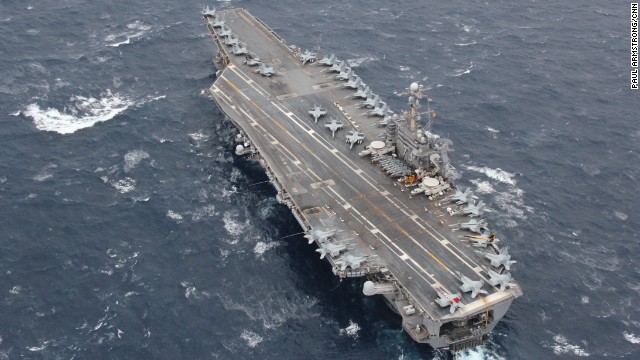 As the United States prepared to mark Thanksgiving, the centerpiece of the U.S. 7th fleet in the Pacific, the USS George Washington, was deployed off the Japanese island of Okinawa.
As the United States prepared to mark Thanksgiving, the centerpiece of the U.S. 7th fleet in the Pacific, the USS George Washington, was deployed off the Japanese island of Okinawa.






















No comments:
Post a Comment